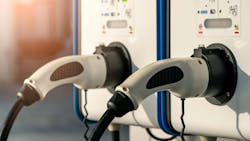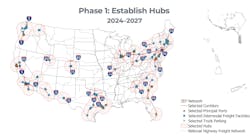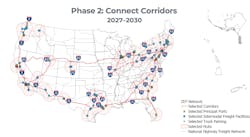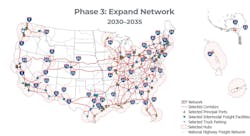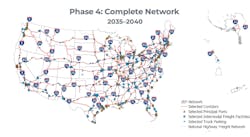New freight corridor strategy maps future of zero-emission fleets
For heavy-duty trucks to transition to zero-emission vehicles, they will need access to new charging and alternative fueling infrastructure nationwide. A new federal document maps out the development of infrastructure for zero-emission, heavy-duty vehicles through the next 15 years.
Federal agencies this week released the National Zero-Emission Freight Corridor Strategy, a 318-page document to guide charging and hydrogen fueling infrastructure development for medium- and heavy-duty vehicles through 2040.
Major equipment manufacturers in the EV space voiced support for the strategy.
“High level, this is a road map for how to think about practically achieving a really gargantuan task, which is to enable a different fueling paradigm for the heavy-duty truck sector throughout the country,” Tom Ashley, VP of utility and government relations for Voltera, told FleetOwner.
Background of the ZE freight corridor strategy
The federal agencies behind the strategy include the Joint Office of Energy and Transportation, the Departments of Energy and Transportation, and the Environmental Protection Agency. The strategy aims to advance the Biden administration’s freight industry decarbonization goals by developing EV freight corridors.
See also: Take the fork in the road to zero
According to the Federal Highway Administration, investments through the strategy would help provide “ubiquitous and convenient access to electric vehicle charging and hydrogen refueling along our nation’s freight corridors and at intermodal freight facilities and high-usage ports.”
This infrastructure would help fleets better plan their transitions from fossil fuels. Most electric medium- and heavy-duty trucks today operate for short-haul and regional routes because there is not enough charging infrastructure to support long-haul operations for these vehicles.
The document aligns with 2023’s U.S. National Blueprint for Transportation Decarbonization, which includes increasing ZE commercial vehicle sales to 30% by 2030 and 100% by 2040.
Coinciding with the new strategy, the Federal Highway Administration also announced the designation of National EV Freight Corridors along key roadways. These corridors, required by the Infrastructure Investment and Jobs Act, identify areas with a near- and long-term need for EV charging infrastructure. The designated EV freight corridors essentially mirror the National Highway Freight Network with a few modifications.
“I am very excited about the opportunity that is presented to Voltera and the market associated with the strategy,” Ashley said. “One of the things I’m most excited about with the strategy is the opportunity for fleets to gain more certainty around a planning foundation because I think a lot of fleets—maybe not in California, but certainly that operate in other parts of the country—just haven’t known what to do.”
What’s in the strategy
The National Zero-Emission Freight Corridor Strategy outlines a four-phase approach. The approach starts by funding zero-emission freight infrastructure in areas with substantial freight volume and short-distance operations. Over time, the zero-emission freight vehicle infrastructure area would expand and support long-haul operations and Class 8 vehicles. The phases are as follows:
- 2024-27: Establish priority hubs based on freight volumes
- 2027-30: Connect hubs along critical freight corridors
- 2030-35: Expand corridor connections initiating network development
- 2035-40: Achieve national network by linking regional corridors for ubiquitous access
The strategy recognizes its initial priority hubs and corridors will not have the power needed for Class 8 vehicles. Instead, the first two phases would primarily support local freight movement by Class 3-7 vehicles, such as first- and last-mile delivery. The final two phases, spanning 2030 through 2040, identify Class 8 vehicles as primary users.
Phase 1: Establish priority hubs
From 2024 through 2027, Phase 1 focuses on areas best suited for battery-electric fleets: Class 3-7 vehicles performing predominantly return-to-base operations like drayage and LTL/parcel delivery. The first phase aims to support 100-mile freight ecosystems around major corridors and ports.
“I think the strategy of starting with a focus on short-haul routes and associated hubs is real—that’s what’s happening right now,” Ashley said. “Those are the vehicles that are available right now. The charging solutions are available right now for those use cases. I think that makes a lot of sense as a very—maybe not easy— but very achievable foundation in the first phase of the vision.”
In these first years, the strategy also focuses its hubs in key states, disproportionally impacted communities, and facilities along identified corridor planning projects. The plan’s key states are those with markets and regulations that are more hospitable for zero-emission vehicle infrastructure, such as California.
“The deployment of those [zero emission] trucks thus far is heavily skewed toward California and heavily skewed around the ports in California,” Ashley said. “In other geographies, it is pretty early days. The trucks are in some cases running real routes but really just in a pilot data gathering, operational experience gathering mode.”
Phase 2: Connect hubs along freight corridors
The second phase connects the priority hubs through a wide-reaching network of selected corridors. From 2027 through 2030, the strategy is to begin infrastructure buildout beyond key states.
Phase 2 introduces the DOE’s Regional Clean Hydrogen Hubs, as the authors expect more fleets to embrace hydrogen fuel cell-electric trucks.
See also: Feds fueling $8B nationwide hydrogen hub investment
“There’s a very strong view that’s prevalent around the industry that, right now, zero-emission trucks are battery-electric—but at some point in the future, they may also be supported by hydrogen,” said Ashley. “I think that’s an interesting dynamic associated with the temporal phases of this plan: the first phase, there’s a majority view that the trucks that are operating around those hubs or routes are battery-electric trucks. And there is the opportunity in further phases for some—or more than some—of those trucks to be hydrogen-fueled.”
Phase 3: Expand corridor connections
In Phase 3, the priority hubs will expand to include more ports and freight facilities. The corridor connections would also expand across the country, supporting zero-emission freight transport along the four major east-west and north-south freight routes: I-10, I-70, I-80, and I-95.
The strategy’s authors anticipate that during this phase, from 2030 through 2035, both battery-electric and hydrogen fuel cell equipment would be prevalent. The infrastructure at this stage would still primarily support short-haul and regional operations.
Phase 4: Complete the network
The final phase of the strategy prioritizes the vast majority of the National Highway Freight Network, supporting private investment that enables ubiquitous access to zero-emission freight infrastructure along corridors. Zero-emission freight hubs also expand to include truck parking facilities to service commercial vehicles across all use cases.
OEM responses
Major equipment manufacturers operating in the EV space voiced support for the strategy.
In January, major OEMs Daimler Truck North America, Volvo Group North America, and Navistar formed Powering America’s Commercial Transportation, a coalition to promote nationwide zero-emission infrastructure nationwide. PACT plans to work with the Joint Office of Energy and Transportation in guiding the strategy's rollout.
"Many PACT members—who are investing heavily in the future of zero-emission commercial transportation—helped inform this strategy,” Brien Sheahan, PACT board secretary, told FleetOwner. “PACT will draw on its members’ diverse expertise to partner with JOET and help advance its priorities.”
Sheahan also expressed support for the strategy on behalf of the OEM coalition.
“Zero-emission big rigs are relatively new technologies,” Sheahan said. “Development has come a long way in recent years, but M/HD ZEVs on the market today still don’t meet most duty cycle or application needs. We look forward to continued engagement with all stakeholders to accelerate the buildout of nationwide charging infrastructure for M/HD ZEVs.”
The Heavy-Duty Leadership Group, established by Ford, Cummins, Eaton, and BorgWarner, applauded the strategy’s phased-in approach.
“The National Zero-Emission Freight Corridor Strategy rightfully directs federal agencies to consider all available technology adoption and market dynamics while focusing on areas where the deployment of commercial zero-emission vehicles could be accelerated through public and private funding as well as the targeted buildout of essential infrastructure,” wrote Patrick Quinn, executive director of the HDLG, in a statement. “We appreciate the strategy’s recognition that the transition to decarbonization of the freight sector must take into account critical factors including energy costs, grid readiness, industry concentration, and available funding to ensure we build out necessary infrastructure.”
Volvo Group North America also supported the strategy, calling it a “positive step.”
“The strategy supports Volvo Group’s ambition to be 100% fossil-fuel free by 2040 and complements our recent partnership with other stakeholder to form PACT,” Dawn Fenton, VP of government relations and public affairs for Volvo Group North America, told FleetOwner. “We hope this corridor strategy will serve as a catalyst, emphasizing the need for all stakeholders to act now, and we look forward to working collaboratively with the administration in support of this goal.”
About the Author
Jeremy Wolfe
Editor
Editor Jeremy Wolfe joined the FleetOwner team in February 2024. He graduated from the University of Wisconsin-Stevens Point with majors in English and Philosophy. He previously served as Editor for Endeavor Business Media's Water Group publications.
